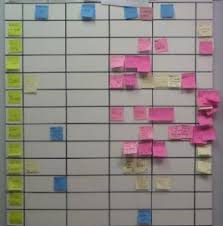
Visual project management makes knowledge work visible (just like the parts on the factory floor), so we can see it, react to changes better, and keep the project flowing quickly to completion.
Its primary goal is to make the work in the product development system more visible so it can be better managed.
Consider this. If you were to survey the traditional manufacturing floor, how would you know where the system was breaking down? Sometimes there would be flashing lights indicating a fault in the system, but even if there weren't any, you could still tell which machine was having issues by the big pile of parts in front of it.
But when you look around development departments today and a team of knowledge workers, how can you tell where the problems are? Where is the task that is the most critical today? Where is the blockage which is delaying your project today? Where is the one that will delay your project tomorrow? These problems are hidden from view.
Visual work management was born to solve this problem of ‘invisibility’ of knowledge work.
It's important to note there are many types of visual project management tools - from manual boards to visual project management software
The most common form of visual project management consists of sticky notes (stickies) on a white board or similar. The primary formats include Wall Gantt, Generic Kanban boards, and Process-specific Kanban boards.

Figure 2: Wall Gantt
A Wall Gantt is characterized by dates or weeks in the columns, resources in the rows, and tasks of any kind on the stickies. A Process-specific Kanban has steps of a process as columns and the items going through the process on the stickies (e.g., a new software feature undergoing design, coding, unit testing, and integration steps).
In the more advanced cases, there can be any number of different colors, lanes, columns, holding areas, resources, dots, icons, magnets, tag-along stickies, and other aspects that show different information under different conditions. For many reasons, these two formats are used relatively rarely among hardware teams.
More common among hardware teams today is a Generic Kanban board. In this format, tasks of any kind go through a very generic ‘process’ from the backlog to in-process, to done. Sometimes there are planning steps or various other high-level stages, when the process is standard enough for those other steps to be part of it regularly.
Figure 4: Generic Kanban Board
Most digital visual project management tools available today use Generic Kanban and/or Process-specific Kanban formats.
Before we developed Playbook, we tried each of these different formats of project boards to accelerate projects. Each form was beneficial in some ways and depending on the application, some more beneficial than others. However, each one had significant deficiencies because, simply put, hardware development project management is more complicated.
If you have read our series on the many differences between Software and Hardware development and the applicability of Agile techniques to hardware projects, you know that we see several clear and largely unavoidable differences between hardware and software projects.
We will expand the list of differences here to include more aspects which impact the best format and tools to use :
Although traditional visual project management boards (such as Kanban) are usually better than nothing, there are many reasons why even the digital versions don't work very well for hardware project management in product development.
New visual project management tools such as Playbook, which are purpose built for hardware development, increase the effectiveness of visual project management in improving new product development systems.
Everyone can clearly see the system at work, team members’ daily priorities, bottlenecks, overloads, multitasking, blockages, and queues. Product development teams can see when the system is overloaded with work, see the impact of delays and understand their costs, effectively evaluate and manage all types of risk, and much more.
Making sure the team is working on the right thing at the right time is critical. In fact the number one cause of project delays is team members working on the wrong work. Watch this video to understand how projects get delayed one wrong task at at time.
10 Benefits of Visual Management Software
Lean project management
Lean project management methodology
Lean project management Kanban
Lean project management principles
Lean project management resource management
Lean project management Pull vs. push
Lean project management task management
Lean project management and shared project buffers
Lean project management and decentralized planning
Daily stand-up meetings
5 Visual Project Management Software Requirements
Lean Visual Management and Kanban
Visual Management Boards
Four Essential Features of a Visual Management Board
2 Essential Features of Visual Management
Visual Project Management ROI

Address
PO Box 18027
Boulder, CO 80308
303-323-4296
info@accuer.com
Lean Project Management
Lean Product Development
Agile Development